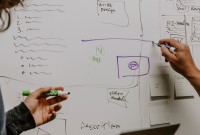- Home
- Business Processes
- Industry Knowledge
- Aerospace Industry
- Automotive Industry
- Banking Domain
- BFSI Industry
- Consumer/ FMCG Industry
- Chemicals Industry
- Engineering & Construction
- Energy Industry
- Education Domain
- Finance Domain
- Hospitality Domain
- Healthcare Industry
- Insurance Domain
- Retail Industry
- Travel and Tourism Domain
- Telecom Industry
- Leadership Skills
- eLearning
- Home
- Leadership
- Leadership Theories
- Ohio State Studies
Ohio State Studies
Early studies on leadership were done at Ohio State University using the Leader Behavior Description Questionnaire to identify the leader's observable behaviors. Ohio State study on leadership found two behavioral characteristics of leadership - people-oriented (consideration) and task-oriented (initiating structure) leadership style.
Ohio State Studies on Leadership Styles:
As leadership studies that were aimed at identifying the appropriate traits didn't yield any conclusive results,, Stogdill (1957) at the Bureau of Business Research at Ohio State University initiated ‘a series of researches on leadership in 1945. He, along with his colleagues, studied leader behavior in numerous types of groups and situations by using a “Leader Behavior Description Questionnaire (LBDQ)”.
Leader Behavior Description Questionnaire (LBDQ):
The Leader Behavior Description Questionnaire (LBDQ) was developed by the staff of the Personnel Research Board, The Ohio State University, as one project of the Ohio State Leadership Studies, directed by Dr. Carroll L. Shartle. LBDQ constituted of a list of 150 statements from their generated responses that included 1,800 statements. The resulting questionnaire is now well-known as the “LBDQ” or the “Leaders Behavior Description Questionnaire”. The LBDQ is published by the Bureau of Business Research, College of Commerce and Administration, The Ohio State University; Columbus, OH. The version presented below was copyrighted in 1957 and may still be ordered if you wish to use it.
The LBDQ’s list of questions was designed to measure nine different behavioral leadership dimensions. The LBDQ provides a technique whereby group members may describe the behavior of the leader, or leaders, in any type of group or organization, provided the followers have had an opportunity to observe the leader in action as a leader of their group. LBDQ questions given below are only for research and knowledge purposes.
|
SN |
Leader Behavior Description |
Factors |
|
1 |
S/he does personal favors for group members. |
Consideration |
|
2 |
S/he makes her/his attitudes clear to the group. A B C D E |
Initiating Structure |
|
3 |
S/he does little things to make it pleasant to be a member of the group. |
Consideration |
|
4 |
S/he tries out his new ideas with the group. |
Initiating Structure |
|
5 |
S/he acts as the real leader of the group. |
Not Used |
|
6 |
S/he is easy to understand. |
Consideration |
|
7 |
S/he rules with an iron hand. |
Initiating Structure |
|
8 |
S/he finds time to listen to group members. |
Consideration |
|
9 |
S/he criticizes poor work. |
Initiating Structure |
|
10 |
S/he gives advance notice of changes. |
Not Used |
|
11 |
S/he speaks in a manner not to be questioned. |
Initiating Structure |
|
12 |
S/he keeps to her/himself. |
Consideration |
|
13 |
S/he looks out for the personal welfare of individual group members. |
Consideration |
|
14 |
S/h assigns group members to particular tasks. |
Initiating Structure |
|
15 |
S/he is the spokesman of the group. |
Not Used |
|
16 |
S/he schedules the work to be done. |
Initiating Structure |
|
17 |
S/he maintains definite standards of performance. |
Initiating Structure |
|
18 |
S/he refuses to explain her/his actions. |
Consideration |
|
19 |
S/he keeps the group informed. |
Not Used |
|
20 |
S/he acts without consulting the group. |
Consideration |
|
21 |
S/he backs up the members in their actions. |
Consideration |
|
22 |
S/he emphasizes the meeting of deadlines. |
Initiating Structure |
|
23 |
S/he treats all group members as her/his equals. |
Consideration |
|
24 |
S/he encourages the use of uniform procedures. |
Initiating Structure |
|
25 |
S/he gets what s/he asks for from her/his superiors. |
Not Used |
|
26 |
S/he is willing to make changes. |
Consideration |
|
27 |
S/he makes sure that her/his part in the organization is understood by group members. |
Initiating Structure |
|
28 |
S/he is friendly and approachable. |
Consideration |
|
29 |
S/he asks that group members follow standard rules and regulations. |
Initiating Structure |
|
30 |
S/he fails to take necessary action. |
Not Used |
|
31 |
S/he makes group members feel at ease when talking with them. |
Consideration |
|
32 |
S/he lets group members know what is expected of them. |
Initiating Structure |
|
33 |
S/he speaks as the representative of the group. |
Not Used |
|
34 |
S/he puts suggestions made by the group into action. |
Consideration |
|
35 |
S/he sees to it that group members are working up to capacity. |
Initiating Structure |
|
36 |
S/he lets other people take away her/his leadership in the group. |
Not Used |
|
37 |
S/he gets her/his superiors to act for the welfare of the group. |
Not Used |
|
38 |
S/he gets group approval in important matters before going ahead. |
Consideration |
|
39 |
S/he sees to it that the work of the group members is coordinated. |
Initiating Structure |
|
40 |
S/he keeps the group working together as a team. |
Not Used |
How the Study was conducted?
The studies were conducted on Air Force Commanders and members of bomber crews, officers, non-commissioned personnel, civilian administrators in the Navy Department, manufacturing supervisors, executives, teachers, principals and school superintendents and leaders of various civilian groups. As part of the study, the LBDQ was administered to these various groups of individuals which ranged from college students and their administrators, private companies including military personnel. One of the primary purposes of the study was to identify common leadership behaviors. The LBDQ was administered in a wide variety of situations.
They did not have any satisfactory definition of leadership. They also did not think leadership is synonymous with `good' leadership. After compiling and analyzing the results, the study led to the conclusion that there were two groups of behaviors that were strongly correlated. The Ohio State studies examined leaders’ task versus people orientation. Two dimensions of; leadership continually emerging from the study were `consideration' and the other was ‘initiating structure’. These were defined as Consideration (People Oriented behavioral Leaders) and Initiating Structure (Task Oriented Leaders).
Consideration – People Oriented:
Consideration reflects the extent to which individuals are likely to have job, relationship characterized by mutual respect for subordinates, ideas and consideration of subordinates, feelings. You may like to describe it as the behavior of the leader indicating friendship, mutual trust, respect and warmth in the relationship between the leader and his group members. The people oriented leaders are focusing their behaviors on ensuring that the inner needs of the people are satisfied. Thus they will seek to motivate their staff through emphasizing the human relation. People oriented leaders still focus on the task and the results; they just achieve them through different means.
Examples of observed behavior of the leader under consideration are as follows:
Consideration:
- The leaders find time to listen to group members
- The leader is willing to make change
- The leader is friendly and approachable
- The leader is Encouraging
- The leader is observing
- The leader is listening
- The leader provides coaching and mentoring
Initiating Structure – Task Oriented:
Initiating structure reflects the extent to which individuals are likely to define and structure their roles and those of their subordinates towards goal attainment. In other words, it is the behavior of the leader which deals with the relationship between him and the work-group and tries to establish well-defined patterns of organization, channels of communication and method of procedure. The task concerned leaders are focusing their behaviors on the organizational structure, the operating procedures (S.O.P.) and they like to keep control. Task-oriented leaders are still concerned with their staff motivation; however it's not their main concern.
Examples of observed behavior of the leader under initiating structure are as follows:
Initiating Structure:
- The leader assigns group members to particular tasks
- The leader asks the group members to follow standard rules and regulations
- The leader lets group members know what is expected of them
- The leader initiates
- The leader organizes
- The leader clarifies
- The leader works towards information Gathering
Prescribed Activity:
In the above example of items check how frequently as a leader you engage yourself by marking A(Always), O(Occasionally) or N(Never), against each one of the items in the list of statements given above. This may help you to know your own style of leadership. One can do this exercise by observing and judging the behavior of the leader in a work situation.
Conclusions from the Study:
Conceptually, the Ohio State studies helped to shift the focus of the field from a universal trait approach to a more situational, behavioral-based view. The Ohio State studies contributed a model of programmatic construct, validation and investigation, and provided future researchers with useful research instruments. These studies, attempted to find what behaviors substantially accounted for most of the leadership behavior described by employees. Beginning with over a thousand dimensions, researchers narrowed the list to two explained above. Both factors were found to be associated with effective leadership. Followers of leaders who are high in consideration were more satisfied with their jobs; more motivated, and had more respect for their leader. Leaders who were high in initiating structure typically had higher levels of group and organization productivity along with more positive performance evaluations. The findings of the LBDQ indicate that a successful leader will possess a strong ability to be considerate of others, as well as an ability to initiate structure. In the workplace this might be a manager who is very personable and understanding, but is also able to set expectations and guidelines that require workers to be motivated, efficient, and able to produce high-quality work.
Related Links
You May Also Like
-
All the teams are dynamic in nature and they take time to come together, they form, develop, and grow in stages, over a period of time. Teams go through five progressive stages: Forming, Storming, Norming, Performing and Adjourning. In this article, we want to introduce you to these stages of team development and certain strategies that you can use to help the team grow and develop in each of these stages.
-
McGregor's Theory X and Theory Y
McGregor created Theory X and Theory Y of human work motivation and explained two styles of management known as authoritarian (Theory X) and participative (Theory Y). Theory X management assumes most people will attempt to avoid work whereas Theory Y managers trust their people to take ownership of their work.
-
Team leadership theory is a recent leadership theory that does not discriminate between the leader and the other team members. The approach considers contributions from each team member to be critical for organizational success. This approach focused on the overall team effectiveness and team problems are diagnosed and action is taken to remediate weakness. This approach provides for taking corrective action when the leader deems necessary.
-
Social learning theory is a theory of learning process that states that most human behavior is learned observationally through modeling. Behavior change can occur in response to leader modeling and learning occurs through the observation of rewards and punishments. The focus of this approach has been teaching leadership across formal and informal settings.
-
The style approach emphasizes that one style of leadership behaviour cannot be effective in all situations. Earlier theories treated leadership exclusively as a personality trait and behavior approach has widened the scope by including the behaviors of leaders and what they do in various situations. Explore how you can benefit from the concepts to understand your own behaviors and what are some of the leadership tools based on the style approach to leadership.
-
Transactional Theory of Leadership
Transactional leadership theory is based on the concept of rewards and punishments. The transactional management approach assumes that the desires of the leader and follower are different and leaders give followers something in exchange for getting something they want. Transactional leaders expect followers to be compliant and focuses on structure, instruction, monitoring, organization, or performance to get tasks completed on time.
-
The Vroom-Yetton model is designed to optimize for the current situation the leadership style for best decision-making. Its a decision model formulated with contribution from Arthur Jago on how to make group decisions. The leader must gather information from the team prior to making the decision and involves more people in the decision process.
-
Leadership has been defined in different ways by different sets of scholars. In very simple terms leadership can be defined as the skill of a person to influence an individual or a group for achievement of a goal in a given situation. One can use different dimensions and perspectives to define leadership. Through the evolution of leadership thought, leadership has been defined in various ways discussed here.
-
Contingency Theories in Action
Contingency theory suggests matching the best leader to a specific situation based on situational factors and the leadership style. The practical application of theory can be done in various ways. The workplace example is to determine the best candidate for a given set of requirements using the LPC score. Applying the model to determine a leader's ability to adapt in the scenario of a new project etc..
-
Functional leadership theory addresses specific leader behaviors that are expected to contribute most to the organizational effectiveness by focusing on how the leadership process occurs. The leader should ensure that all needs of the group get addressed.
Explore Our Free Training Articles or
Sign Up to Start With Our eLearning Courses

About Us
Learning
© 2023 TechnoFunc, All Rights Reserved










